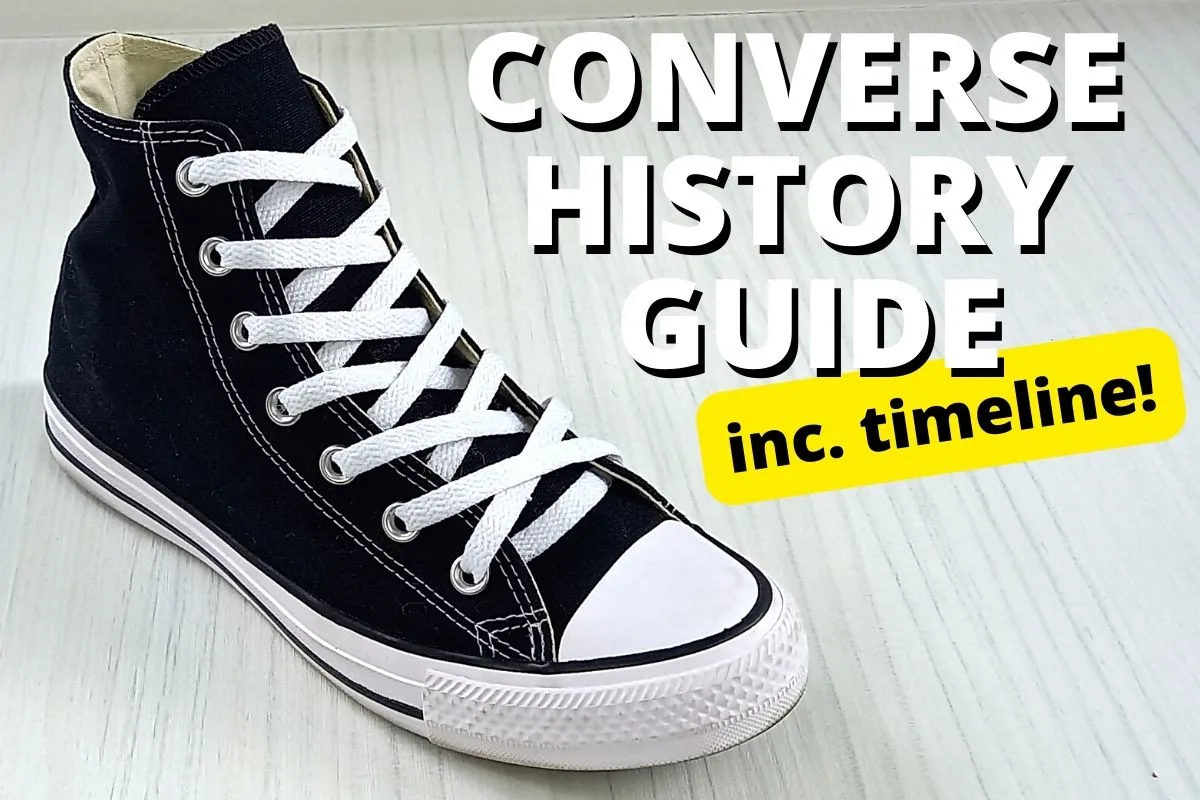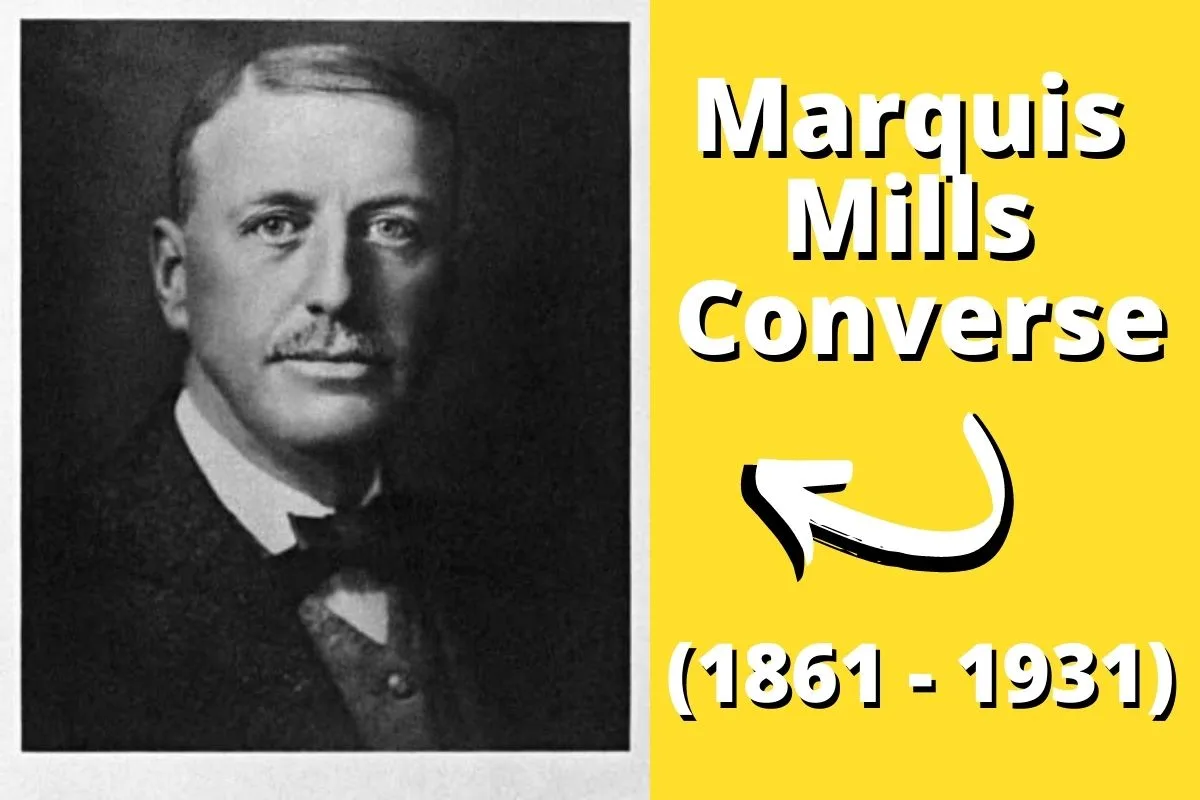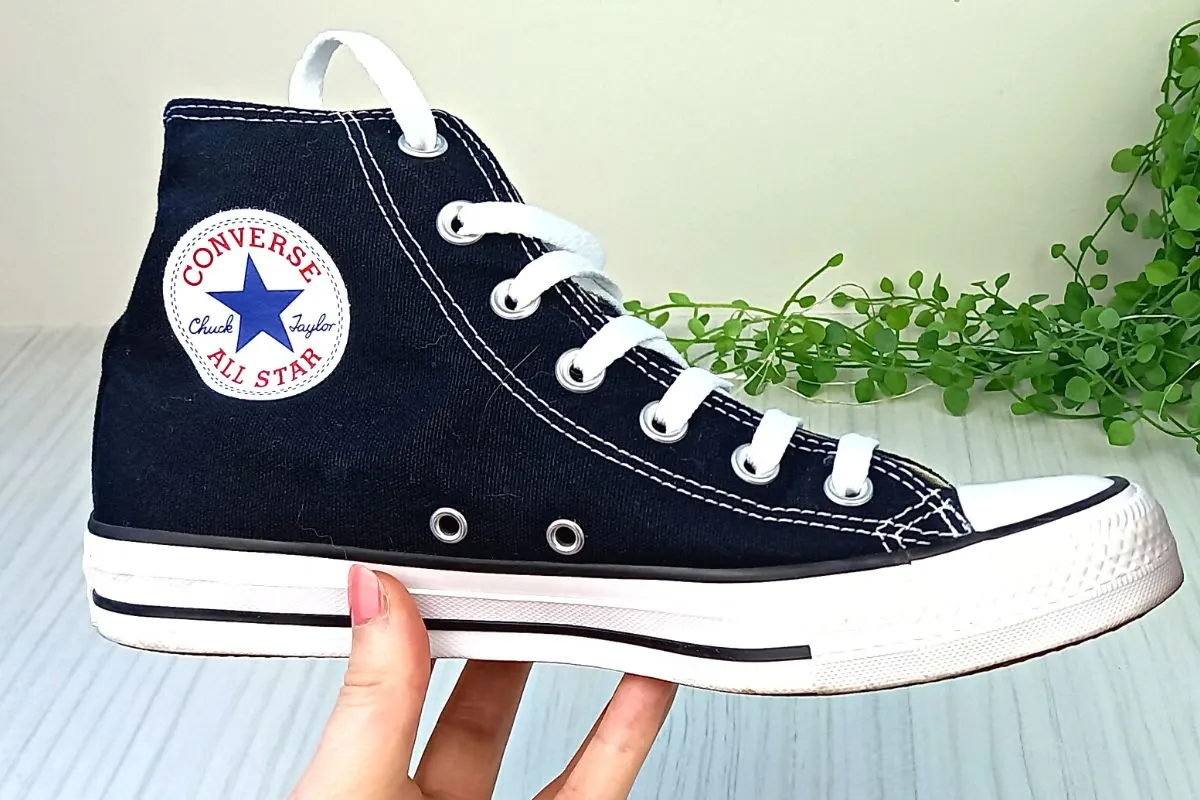Converse has been a leading brand in the shoe industry for as long as most people can remember. With features that are immediately recognizable and a casual look that competitors hardly match, it’s no surprise that other footwear producers attempt to create true-to-life knockoffs. How did this popular shoe brand come to be, and why is it enjoying its success today?

Marquis Mills founded Converse in 1908. The All-Stars were released in 1917, and Chuck Taylor took over marketing and sales in 1921. Soon Converse’s popularity soared, with more than 60% of Americans have owned a pair, yet the brand went through many ups and downs to reach its legendary status.
Does the legacy of the All-Stars interest you? Alright then – tie the laces of your favorite pair of chucks – we’re stepping out on a passage through time to discover the history of the iconic Converse shoes and all the challenges the brand has faced along the way.
The Timeline Of Converse Shoes’ History
The Converse shoe company, as expected, has a dynamic (and at times turbulent) history. Their rise to becoming one of the world’s most recognizable brands is filled with ups and downs but studying it clarifies why exactly this shoe’s shape, style, and logo are synonymous with American culture.
When Was Converse Founded?
Marquis Mills Converse, born in 1861, used to work as a manager at a footwear manufacturing firm and his experiences here instilled a passion for footwear.

Legend has it that his inspiration for founding his footwear company started when he slipped down a flight of stairs. This fall gave him the idea of creating shoes with a gripped sole; rubber would make the perfect material for this purpose.
The Converse Rubber Shoe Company was thus founded in 1908. At its inception, the company sold more than just shoes, specializing in manufacturing products such as car tyers and other general rubber commodities.
The company had a small range of rubber shoes for sale, the most famous being the galoshes. Galoshes, also known as rubberized boots or rubber overshoes, were a kind of rubber shoe that was to be worn over other shoes to prevent them from getting wet or muddy and give the wearer extra traction to prevent them from slipping.
The galoshes, however, weren’t very stylish. Furthermore, they were mostly useful only during winter or rainfall seasons. Therefore, diversifying the company’s range of products was a smart business move and a necessity.
The shoe company, therefore, started designing and producing sports shoes. First, they started with tennis shoes in 1915, and it was a massive hit. In 1917 the Converse All Stars stepped onto the scene: the shoes that would change the Converse Rubber Shoe Company forever.
Originally, the Converse All-Stars were intended for basketball players due to their increased flexibility and grip compared to conventional shoes at the time. The boot was praised for its “non-skid” soles and quickly became popular among the basketball community. However, the sport was not as popular back then as now, and the company needed an additional way to increase sales.
You may also like: Where Are Converse Made? Production FAQs Guide
When Did Converse Become Popular?
Here, Charles “Chuck” Taylor gets his foot in the door. In 1921 he joined the Converse sales team, as he was a semi-professional basketball player with the necessary skill and charisma to be the perfect salesperson.
Chuck also had surprisingly good design ideas for the new All-Stars, and the design proposals he introduced since starting to work for the company are still used in the design today. He proposed canvas uppers, a higher top for better ankle support, and the idea for the rounded All-Star logo we all know. The company included his signature on the patch as an ode to his genius.

As a marketing campaign, Chuck started touring around the country, visiting various YMCAs, high schools, and colleges, teaching them how to play basketball while promoting the shoes. This strategy worked well in introducing the upcoming generations of players to the sport and, consequently, the shoes.
Later, the All-Stars industrial basketball team – a touring team playing in states across America – was founded in Chicago. This team, all stunting the All-Star designs, played a crucial role in promoting the sport and shoes, and soon the popularity of the shoes was soaring.
So much so that the All-Stars became the official shoe of the 1936 Olympic basketball team. The classic white high top, sporting the iconic blue and red stripe with a round star logo, was incredibly resemblant to the American flag. This resemblance helped the shoe evoke a sense of American pride, and this event was incredibly significant in making the shoe an American icon.
The Olympic team wore the All-Stars, and the American troops training for World War Two soon wore it too. That is how Converse became the official shoe of the US armed forces. Now, if that isn’t what constitutes “famous,” it’s hardly possible to think about what else does.
Why Are Converse Called Chucks?
It’s simple; the shoes thrived under the leadership and innovation of Charles “Chuck” Taylor; furthermore, people started referring to the shoes as “chucks” because his signature was the logo. Converse shoes, however, go by many other names too.
A few honorable mentions are:
- Cons
- Chuck Taylors
- Chucky Ts
The Post-World War Period For Converse
After the Second World War, the popularity of chucks grew dramatically. This boost can be attributed to multiple factors. Firstly, the shoes have already established themselves as a distinctly American brand through use in the army, on basketball teams, and even as a staple of casual American fashion.
Secondly, the popularity of basketball as an American sport rose at a rapid pace after the war. The NBA is formed by merging its predecessors, the National Basketball League (NBL), and a separate entity, the Basketball Association of America (BAA). Soon enough, all high school, college, and professional players ran around in chucks.
Finally, it could be attributed to the great economic growth of America in the post-war period, allowing general consumers to easily afford a new pair of kicks. The increased success led to even more brand evolution, and new shapes and colors came onto the scene, always resembling the original design.
By 1957, Converse came to own 80% of the American sneaker market. This sparked interest from other sneaker companies, such as Nike and Reebok, and competition intensified greatly. These companies new to the game were introducing innovations that aid athletes at a pace much faster than Converse could keep up, and as a result, its popularity began to fade.
The sneaker industry, however, also spread to the general population, and sneaker culture became integrated into everyday fashion. People liked the way that it looked and the way that it felt, and soon enough, it even infiltrated various parts of popular culture, providing another gateway for effective marketing.
Converse As A Pop-Culture Icon
Google some of your favorite artists from the 70s through to the 90s, and you’re sure to see a couple of them sport a pair of chucks. Even though the shoes were slowly being rooted out of the game of basketball, it gave artists preferring an alternative look (i.e., most artists) an opportunity to enjoy a fresh style.
The brand became especially popular among the grunge and punk rock scene. Perhaps you’ve noticed celebrities such as Kurt Cobain of Nirvana wear the classic black and white design in a couple of photos and interviews.
However, chucks were not exclusive to the rock scene, as West Coast rappers frequently wore the shoes. Various other celebrities, such as actors, also profess their love for the shoe. Jason O’Mara once said: “Every guy needs a pair of beaten-up Converse Chuck Taylors. The coolest sneakers in the world.”
Skaters also welcomed the shoes as their preferred brand of action. The durable canvas tops and grippy rubber bottom made it the perfect companion to shred some rails. Furthermore, it was affordable enough for anyone to acquire.
Converse’s pop-culture influence doesn’t just end there. The shoes had the opportunity to start in famous and even cult classic movies such as Back to the Future, Grease, Rocky, and Stand by Me. The brand occasionally releases special editions celebrating these features or the celebrities that used to wear them.
Celebrities that are known to have sported Converse shoes:
- The Ramones
- Aerosmith
- U2
- Twisted Sister
- Pearl Jam
- Alice In Chains
- System of a Down
- Cypress Hill
- Deftones
- Ben Affleck
- Julia Roberts
- Jessica Alba
- Bella Hadid
- Rihanna
- James Dean
- Joaquin Phoenix
Just about every other celebrity has been spotted wearing the iconic brand. It’s not surprising, as it is believed that over 60% of Americans own or have owned a pair of Converse at some point in their life. Converse’s annual sales reports certainly support these claims as well.
The Details Regarding Converse’s Economic Turmoils
Despite the brand’s massive popularity, the company certainly had some troubles along the way. For instance, it had to file for bankruptcy three times over the hundred-odd years since its inception. Nevertheless, the brand is still alive today and booming more than ever. Therefore, one has to ask what exactly happened on a managerial level to keep the business afloat for so long.
The Converse Rubber Shoe Company’s First Bankruptcy
When the Converse Rubber Shoe Company was first founded, Marquis Mills had about $250,000 capital available. Certainly, enough money to start a small business, but innovation and savvy grew the business – not an immense amount of leverage.
In fact, in 1911, they did not have any bonded indebtedness. The Converse Rubber Shoe Company’s financial statements also recorded that they’d sold $150,000 of preferred stock to Hooper, Kimball & Williams and that net earnings accumulated to over five times the size of the preference dividend responsibilities.
The Converse company was affiliated with the US Army much earlier than one would think. In 1914 already, they’d undergone a contract with the United States Navy Department to provide them with 1,200 pairs of shoes. During the same time that they won the contract, they were selling 7,000 shoes per day.
A year later, in 1915, the company had amassed $700,000 in capital. Over the following months, the company expanded its production, constructing new plants and growing its capital base to $950,000 by selling more cumulative preferred stock.
After the success of the tennis shoe, Converse released its “Big Nines” to the market, boasting nine big points of shoe supremacy. These points include the signature ankle patch, a cork innersole, leather lacings, thick live rubber soles, and so forth.
The Big Nines enjoyed good commercial success as a massive advertising campaign backed it. The Big Nines eventually led to the creation of “non-Skids,” which were the predecessors of the All-Stars, though the latter’s popularity quickly surpassed that of its origins.
Despite the success that the brand started to enjoy with its flagship – the Chuck Taylor All Stars – the end of the roaring 20s were closing in, and you know what that means… That’s right: the start of the Great Depression. Consequently, the company was forced to file for bankruptcy.
The company was therefore acquired by Mitchell B. Kauffman, president of Hodgman Rubber Company. A year later, though, he had suffered an untimely death, and control consequently passed on to Albert Wechsler – the late Kauffman’s successor.
The Stone Family’s Reign And A Frequent Ownership Change
The early 1930s marked the start of Converse shoes’ real golden age as the Stone family acquired the Convers Rubber Shoe Company. For thirty-nine years, this family ran the business on a path toward legendary status, with a combination of great marketing, effective management, and continuous expansion of production plants. Consequently, the shoe company became a long-term market leader.
Under the Stone family’s sound leadership, the company expanded its contracts with the US Navy, the National Basketball Association, tennis players, and Olympic athletes. However, the glory years would not last forever as competition grew tougher.
As a result, the Stone dynasty felt it necessary to diversify beyond the shoe industry and invest in products like textiles, paper and photocopying, plastic, and automotive. This diversification, and more intense advertising campaigns, were not enough to justify keeping the company under the family name, and consequently, it was time to let Converse go.
For the next 10 years, the company would exchange hands repeatedly. Occasionally, sales would jump up again to record highs; at other times, however, the company seemed more like a liability than anything else.
In 1983, the company was again operating under its name when it spun off from its owner, Allied Eltra Corporation, for a purchase of $100 million. Later that year, Converse was selling shares on the NASDAQ market.
As an increasing number of imports started to threaten the domestic market, the management of Converse felt it could counter by increasing its exporting program. Resultingly, the company set up a deal with three foreign corporations to facilitate the manufacturing, distribution, and marketing of Converse boots throughout Japan – a then bustling economy.
While Converse already had a substantial market in Europe since the Second World War, they also upped their strategies. Soon enough, Converse’s international sales increased by over 60% over the North American, European, and Asian continents.
Though international sales picked up, the domestic market was still under much strain, and Converse had to face many problems competing with Nike, Reebok, and more. One such issue was when Converse brand ambassador Magic Johnson complained about his dissatisfaction with the contract since top players signed by other brands were earning substantially more from their deals.
In 1986, Interco acquired Converse, yet soon enough, the parent company showed that it had some problems with liquidity. In 1991, Interco filed for bankruptcy relief. Converse shoes were losing their grip on the market, and the brand had little financial support. In 1994, Converse spun off once again.
The Third And Final Bankruptcy: Converse Is Bough By Nike
In 2001, Converse filed for bankruptcy one last time. The faltering was largely caused by the structural issues caused by Interco’s leadership, an inability to compete with growing rival brands, and financial distress caused by the turn of the millennium. 2003 came, and Nike stepped in to save the day.
Since then, Nike’s company transformation has proved to be an incredibly lucrative investment decision. Revenue grew from $205 million in 2002 to $1.4 billion in 2013. One must be curious how Nike could “just do it?”
It has a lot to do with a complete shift of the shoe’s perception as an affordable staple in the closets of rockers, skaters, and punks to the image of a stylish and exclusive fashion piece. Though, the two images could (and do) live in harmony.
Nike reinforced the idea that converse is also a high-end boot by collaborating with various exclusive brands. Some of these names, more recently, include Commes des Garçons and Off-White. Nike also played on the brand’s popularity among celebrities and everyday people to help boost sales in the first years since its acquisition.
Conclusion
Converse is a brand that is here to stay. Under Nike’s new ownership, fresh marketing strategies, an even greater sphere of influence creating rich connections, and a rich history to back it all up, there is certainly a lot to look forward to for Converse. By blending the old with the new, these shoes will always help athletes, cultural icons, and people like us reach for the stars.
For more Converse content, check out:
Real Converse vs Fake: 15 Ways To Spot Fake Converse
Are Converse Good For Wide Feet? (Size Guide FAQs)
How To Break In Converse (FAST, Painless Methods)
Are Converse Good For Running? – A 30 Day Test
Converse Sizing: Do Converse Run Big or Small? (FAQs/ Chart)

Lorna is a footwear geek and the founder of Wearably Weird. She created a YouTube channel in 2021 for fellow footwear fanatics, dedicated to detail-rich footwear reviews and info. She has a fashion media qualification (awarded in 2011).
